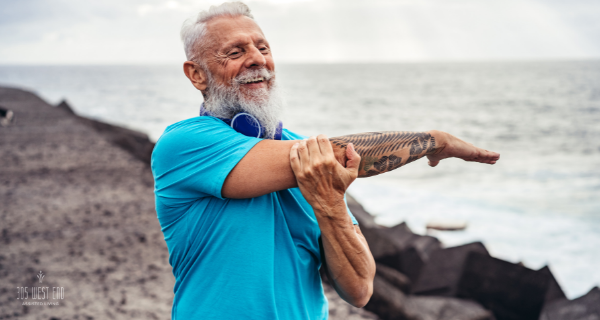Feeling sore when you get out of bed in the morning? Or maybe you have a tough time moving your legs after sitting still for a longer period of time? Stiff joints and tight muscles are common as we age, but they don’t have to be. Spending just a few minutes stretching per day can help you move more freely and enjoy life more fully. Learn more about the benefits of stretching for seniors, as well as simple stretches to help you get started.
Why is Stretching Important for Seniors?
A stretching routine doesn’t need to be complicated, or require a huge investment of time. So how often do you need to stretch, and for how long? Two ten-minute sessions per week is all that is required to help keep your muscles flexible. Stretching first thing in morning, or right before bed is a great way to get started. You could also spend a few minutes stretching after you finish exercising.
Still not convinced? The American Council on Exercise shares the following benefits of stretching:
- Improved range of motion. Regular stretching can help increase the range of motion through your joints – particularly beneficial if you suffer from arthritis.
- Better posture. Stretches that target your lower back, shoulders and chest helps promote correct posture by keeping your back in alignment. Better posture can also help improve your balance – a key element in avoiding falls.
- Improves circulation. Stretching boosts blood flow to your muscles and joints – delivering needed nutrients, which is especially important after exercising.
- Relaxes tight muscles. Muscles that are always tight are not only painful, but they can also hamper circulation. Limited blood flow can prevent nutrients and oxygen from reaching your muscles.
- Decrease your risk for injury. Flexible muscles are more supple, and may be less likely to become injured if you need to make a sudden move.
- Relieves stress. Flexible muscles hold less tension, which may help you feel relaxed, and less stressed.
- Reduces muscle soreness after exercise. Muscles have a tendency to shorten and tighten up after exercise, which can cause pain and discomfort. Spending a few minutes stretching after exercising will help loosen and lengthen your muscles, and reduce the soreness you might feel the next day.
Stretches for Seniors
There are numerous tutorials on YouTube, as well as senior fitness sites like Silver Sneakers and AARP that demonstrate proper stretching technique. Additionally, most provide modifications for beginners – i.e. seated stretches or exercises you can do in bed. Don’t forget to check with your doctor before adding a stretching routine to your daily exercise program.
Relax your body from head to toe with these stretches for seniors from Healthline’s website:
- Neck: Slowly bring your chin to your chest and then turn your head from side to side, holding each position for 15 seconds.
- Shoulders and upper arms: Hold a towel in one hand and allow it to drape over your head and down your back. Grab the bottom of the towel with your other hand and gently pull downwards until you feel tension. Switch hands and repeat the stretch.
- Hamstrings: Lie on your back and lift one leg off the floor. Place your hands around the back of your thigh (not your knee!), and gently pull your leg towards you. Your other leg should remain on the ground. Repeat using the opposite leg.
- Ankles: From a seated position, slowly point your toes up and down, and from side to side, holding each position. Repeat using the opposite foot.
Some pointers as you get started:
- Make sure your muscles are warm before you get started – a short walk is fine
- Don’t forget to breathe deeply as you stretch
- Hold each stretch for 30 seconds
- Resist the urge to bounce – it could cause an injury
- Stretch until you feel tension – not pain
More Health and Nutrition Resources
Discover tips for getting a better night’s sleep, and how you should fuel after exercising.






